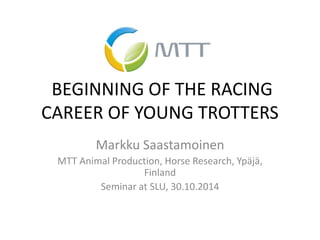
Beginning of the racing career of young trotters, Markku Saastamoinen
- 1. BEGINNING OF THE RACING CAREER OF YOUNG TROTTERS Markku Saastamoinen MTT Animal Production, Horse Research, Ypäjä, Finland Seminar at SLU, 30.10.2014
- 2. Racing performance and success •Is not a single trait, but an underlying trait for ranking and other measures of performance •Combination of physical and mental traits and characters •Speed (< movements, conformation …) •Mental features (trainability, attitude, character/temper …) •Development, health, longevity (precocity, durability, soundness, conformation …)
- 3. •Clear genetic background; heritabilities (h2) for single traits moderately high (0,25 – 0,30) •Low genetic correlations with single conformation traits (e.g. Saastamoinen & Barrey, 2000; Suontama 2013); however, trot movements (at the age 1-3 yrs) have a positive genetic correlation with measures of racing performance (Suontama et al. 2012) •Sex differences; males tended to be better performers, but not at the youngest age classes
- 4. “A good promising young horse” •“Talents”, genetics (“good pedigree” = breeding value) •Precocity •Good learning ability •Good character, sociality, other behaviour •Good health, soundness, ability to bear pain and stand stress
- 5. •Physiology, anatomy, conformation, movements -circulation system (e.g. size of heart) -transport of lactic acid -digestibility -gene mutations •Combinations of those above, compensations •GOOD TRAINING, NUTRITION, MANAGEMENT
- 6. Growth and development •Lot of studies on growth and development of various breeds from 1960’s until today •The growth and development to maturity usually continue to the age of 4-6 years depending on breed; TH and STB are developed “quite fast” •Maturing is not finished when trainers put their (TH, STB) horses to training
- 7. •At the age of 18 mos trotter breeds have achieved appr. 75-80 % and 95 % of their mature weight and height, respectively •Individuals of big adult size are growing slower than their smaller contemporaries; those who grows faster during their first year show slower growth later •Horses born late spring develop faster than those born in autumn (e.g. SBT, FH, TH in FI, US, CAN)
- 8. Figure 1. Growth curves of thoroughbreds (TH), standardbred trotters (STB) and cold-blooded trotters (Finnhorses; FH) based on Hintz et al. (1979), Staniar et al. (2005), Persson and Ullberg (1981), Bengtson and Nydahl (1984), Saastamoinen (1991c), Ahtila and Saastamoinen (2005). Adapted from Ellis & Saastamoinen, 2008
- 9. Phase 1. 12-24 months Growth is still relatively fast; daily weight gain approximately 200-400 g. Breaking and light training begins. Phase 2. 24-30 months Growth rate has slowed clearly; daily weight gain approximately 150-200 g. Training has progressed to light to moderate level aiming at racing. Phase 3. 30-36 months The growth has almost finished and the body is growing in dimensions; muscles are growing due to increased training exercise. Horses are trained at moderate to intense level for racing. Cold-blooded trotters (Finnhorses) are still growing also in height up to the age of 48 months. This height increase is about 2.5 % between 30 and 48 months of age (Saastamoinen, 1991b). Adapted from Ellis & Saastamoinen, 2008
- 10. Studies on factors affecting starting and/or starting age of young trotters •Minkema 1975 (NED) •Bendroth 1981 (SWE) •Klemetsdal et al 1985 (NOR) •Physic-Sheard 1986 (CAN) •Langlois and Blouin 1996 (FRA) •Saastamoinen 1991, 1997 (FIN; e.g. Doctorial thesis Genetic and environmental parameters for measures of racing performance in Standardbred and Finnhorse trotters (1997))
- 11. •Beginning the career early is a desirable feature of trotters •Horses starting young are favoured in genetic selection •Depending on the aims (and thus training intensity) the young horses are well above light exercise level from the beginning of breaking and (gradually) training
- 12. Reasons for non-starting/late starting •Injuries, ailments •Bad character •Lack of talent •Slow growth and development •Growth disorders, abnormalities
- 13. Starting age •Genetic background: h2 for Age at first start ~0.20; Age at breaking 0.25 (FH) •Those SBT born in Jan-Mar were about 6 mos younger at their first start than those born Aug-Oct (supported by French and Canadian studies) •Males (stallions, geldings) entered into breaking, training and racing at younger age than female (not in CAN studies)
- 14. •Horses trained and owned by breeders and those trained by professionals started their career younger than those trained by owners •Talented horses started earlier; starters entered to breaking and training earlier than non-starters •Thus, selection for early career results favours horses starting their career at young age and racing for several years
- 15. •Low age at the beginning of the career was favourable associated with later racing performance and number of years in racing (supported also by Tavernier 1994 (FRA) and Physick-Sheard & Russel 1986 (CAN)) •Early starters are healthier (Darenius et al 1983; Thafvelin & Magnusson 1985) •Thus, success in maiden start and starting young reflect early speed, the horse’s ability to respond to training and sustain training stress
- 16. •Young age at beginning of the career: -reflects the time needed to reach maturity -reflects health, soundness, ability to resist injuries (durability)
- 17. Nutrition, exercise •Adaptation of the bones (skeleton) up to 18 month of age (Nielsen et al). •Fractures increased e.g. in Finland during the last years (?) -Lost of days in training and racing -Exercise and loading -Bone and mineral metabolism, effects of minerals and vitamin D (Nielsen et al 1997, 1998; Ellis & Saastamoinen 2008)
